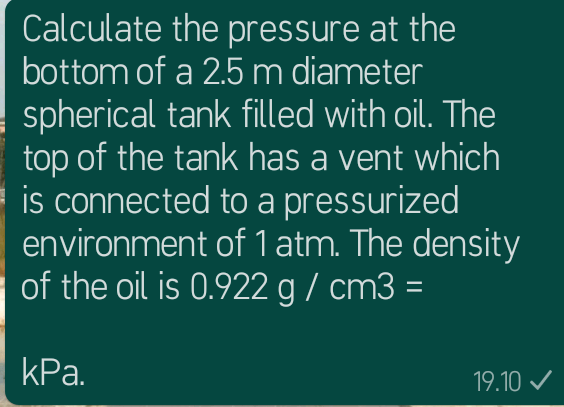Calculate the pressure at the bottom of a 2.5 m diameter spherical tank filled with oil. The top of the tank has a vent which is connected to a pressurized environment of 1 atm. The density of the oil is 0.922 g / cm3 = kPa.
Calculate the pressure at the bottom of a 2.5 m diameter spherical tank filled with oil. The top of the tank has a vent which is connected to a pressurized environment of 1 atm. The density of the oil is 0.922 g / cm3 = kPa.
Introduction to Chemical Engineering Thermodynamics
8th Edition
ISBN:9781259696527
Author:J.M. Smith Termodinamica en ingenieria quimica, Hendrick C Van Ness, Michael Abbott, Mark Swihart
Publisher:J.M. Smith Termodinamica en ingenieria quimica, Hendrick C Van Ness, Michael Abbott, Mark Swihart
Chapter1: Introduction
Section: Chapter Questions
Problem 1.1P
Related questions
Question
Calculate the pressure at the bottom of a 2.5 m diameter spherical tank filled with oil. The top of the tank has a vent which is connected to a pressurized environment of 1 atm. The density of the oil is 0.922 g / cm3 =
kPa.

Transcribed Image Text:Calculate the pressure at the
bottom of a 2.5m diameter
spherical tank filled with oil. The
top of the tank has a vent which
is connected to a pressurized
environment of 1 atm. The density
of the oil is 0.922 g / cm3 =
КРа.
19.10 V

Transcribed Image Text:12.24 d
(76
e-learning.untan.ac.id/l
n2
Hitung tekanan di dasar tangki berbentuk bola berdiameter
2.5 m yang diisi dengan minyak. Bagian atas tangki terdapat
ventilasi yang terhubung ke lingkungan bertekanan 1
atm.Massa jenis minyak adalah 0.922
ed
out of
g
/ cm3
КРа.
us page
Next page
PROUDLY MADE WITH noodle
Expert Solution
This question has been solved!
Explore an expertly crafted, step-by-step solution for a thorough understanding of key concepts.
This is a popular solution!
Trending now
This is a popular solution!
Step by step
Solved in 4 steps

Knowledge Booster
Learn more about
Need a deep-dive on the concept behind this application? Look no further. Learn more about this topic, chemical-engineering and related others by exploring similar questions and additional content below.Recommended textbooks for you

Introduction to Chemical Engineering Thermodynami…
Chemical Engineering
ISBN:
9781259696527
Author:
J.M. Smith Termodinamica en ingenieria quimica, Hendrick C Van Ness, Michael Abbott, Mark Swihart
Publisher:
McGraw-Hill Education

Elementary Principles of Chemical Processes, Bind…
Chemical Engineering
ISBN:
9781118431221
Author:
Richard M. Felder, Ronald W. Rousseau, Lisa G. Bullard
Publisher:
WILEY

Elements of Chemical Reaction Engineering (5th Ed…
Chemical Engineering
ISBN:
9780133887518
Author:
H. Scott Fogler
Publisher:
Prentice Hall

Introduction to Chemical Engineering Thermodynami…
Chemical Engineering
ISBN:
9781259696527
Author:
J.M. Smith Termodinamica en ingenieria quimica, Hendrick C Van Ness, Michael Abbott, Mark Swihart
Publisher:
McGraw-Hill Education

Elementary Principles of Chemical Processes, Bind…
Chemical Engineering
ISBN:
9781118431221
Author:
Richard M. Felder, Ronald W. Rousseau, Lisa G. Bullard
Publisher:
WILEY

Elements of Chemical Reaction Engineering (5th Ed…
Chemical Engineering
ISBN:
9780133887518
Author:
H. Scott Fogler
Publisher:
Prentice Hall


Industrial Plastics: Theory and Applications
Chemical Engineering
ISBN:
9781285061238
Author:
Lokensgard, Erik
Publisher:
Delmar Cengage Learning

Unit Operations of Chemical Engineering
Chemical Engineering
ISBN:
9780072848236
Author:
Warren McCabe, Julian C. Smith, Peter Harriott
Publisher:
McGraw-Hill Companies, The